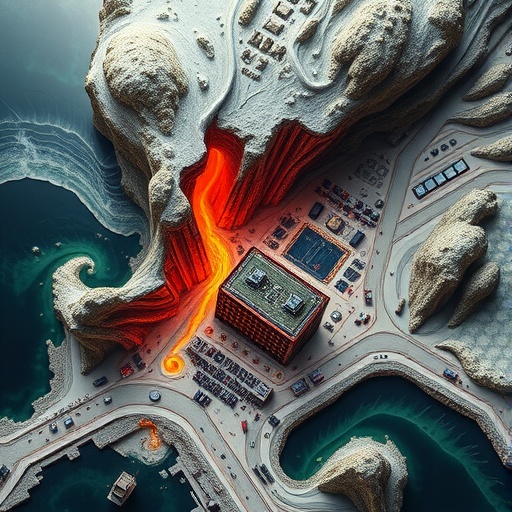In an extraordinary study published in Commun Earth Environ, researchers led by Nazeri, Zollo, and Muzellec have unveiled fascinating insights into the interplay between earthquake rupture velocities and stress drop interactions within the Campi Flegrei volcanic caldera. This evidence enhances our understanding of volcanic seismicity, a crucial area of study considering the potential for catastrophic eruptions in densely populated regions. The findings provide valuable implications for monitoring active volcanic systems and developing risk assessment measures in volcanic regions.
Campi Flegrei, located near Naples, Italy, is one of the world’s most closely monitored volcanic areas, characterized by its complex geological history and significant potential for explosive activity. The caldera has a reputation for its past eruptions and ongoing geological activity, making it a focal point for volcanologists and seismologists alike. The new study sheds light on the dynamics that underlie these natural phenomena, pushing the boundaries of current geological understanding.
Central to the paper’s findings is the relationship between rupture velocity during seismic events and the accompanying stress drop. The researchers have developed a detailed model that quantitatively describes these interactions, which are pivotal for interpreting the behavior of earthquakes in volcanic settings. An earthquake’s rupture velocity describes how fast the seismic waves propagate through the earth, while stress drop refers to the reduction in stress across the fault line during rupture. Understanding both aspects provides crucial insights into the mechanics of earthquakes.
One of the most striking conclusions from this research is that the rupture velocity has a direct influence on the stress drop experienced during an earthquake. Higher rupture speeds, for instance, may correlate with larger stress drops, which implies that the nature of the rupture process can lead to significant alterations in the underground stress field. This interaction underscores the complexities of seismic activity, especially in volcanic areas where traditional models may underestimate the behavior of both the ruptures and the volcanic materials involved.
The researchers utilized an interdisciplinary approach by integrating field data, laboratory experiments, and numerical simulations to arrive at their conclusions. They were able to reconstruct historical seismic events in the Campi Flegrei caldera and pair these with geological data to form a robust dataset from which their mathematical models were derived. This comprehensive methodology not only validates their findings but also sets a new standard for interdisciplinary research in geology.
Moreover, the implications of this research extend beyond academic interest. Understanding the breaking point during seismic activities can significantly inform local authorities and disaster preparedness programs. Particularly, populous regions surrounding the caldera could benefit from an enhanced understanding of when significant eruptions could occur based on the subtle signals that might precede them. Early warning systems could be designed or improved upon based on the vital relationship discovered in this study.
As volcanic eruptions carry risks such as pyroclastic flows, ashfall, and even climate effects, the ability to better predict such events is paramount. Enhanced predictions could greatly diminish the human and economic toll that eruptions typically exact. Risk mitigation strategies grounded in scientific evidence from the Campi Flegrei study could pave the way for new emergency preparedness policies and community engagement initiatives.
Interestingly, this study also emphasizes the need for global collaboration among researchers. The investigation’s highly technical nature calls for a cross-disciplinary approach that fuses the expertise of seismologists, volcanologists, and geophysicists. By sharing data and methodologies, the scientific community can work toward broader models applicable to other volcanic systems worldwide, thereby advancing predictive capabilities on a global scale.
The findings have sparked interest in further research, with questions remaining about the precise mechanisms that govern these interactions. The researchers themselves note that more investigations into varying geological environments must follow to generalize the results beyond the Campi Flegrei caldera. Understanding how different volcanic materials respond under stress could lead to more universally applicable models for predicting rupture behavior in similar geological settings.
As researchers continue to delve into the complexities of volcanic interactions, it becomes evident that ongoing monitoring and study are imperative. The dynamic nature of calderas like Campi Flegrei means that seismic activity will continue to be a pressing concern, necessitating constant vigilance and updated scientific models. With climate change and urban development posing additional challenges, researchers must remain proactive in assessing risks and refining methodologies.
In conclusion, the groundbreaking research by Nazeri and colleagues not only expands the horizons of geological understanding but also serves as a call to action for scientists and policymakers worldwide. The study reflects the profound consequences of seismic activity on human life and infrastructure, urging a more coordinated international effort to study volcanic systems. By advancing our knowledge of earthquake mechanics, we can take significant strides toward safeguarding communities vulnerable to volcanic eruptions, ultimately fostering resilience amidst the forces of nature.
The Campi Flegrei volcanic caldera, with its layered history of eruptions and unique geological characteristics, offers unprecedented opportunities for research. Researchers have only begun to unlock its secrets, and as they do, the insights gained will undoubtedly resonate across the fields of geology, environmental science, and disaster preparedness.
Subject of Research: The interaction between earthquake rupture velocity and stress drop in the Campi Flegrei volcanic caldera.
Article Title: Earthquake rupture velocity and stress drop interaction in the Campi Flegrei volcanic caldera.
Article References: Nazeri, S., Zollo, A., Muzellec, T. et al. Earthquake rupture velocity and stress drop interaction in the Campi Flegrei volcanic caldera. Commun Earth Environ 6, 875 (2025). https://doi.org/10.1038/s43247-025-02808-x
Image Credits: AI Generated
DOI: https://doi.org/10.1038/s43247-025-02808-x
Keywords: Earthquake, Volcanic Caldera, Rupture Velocity, Stress Drop, Campi Flegrei, Seismic Activity, Disaster Preparedness, Geological Research.




